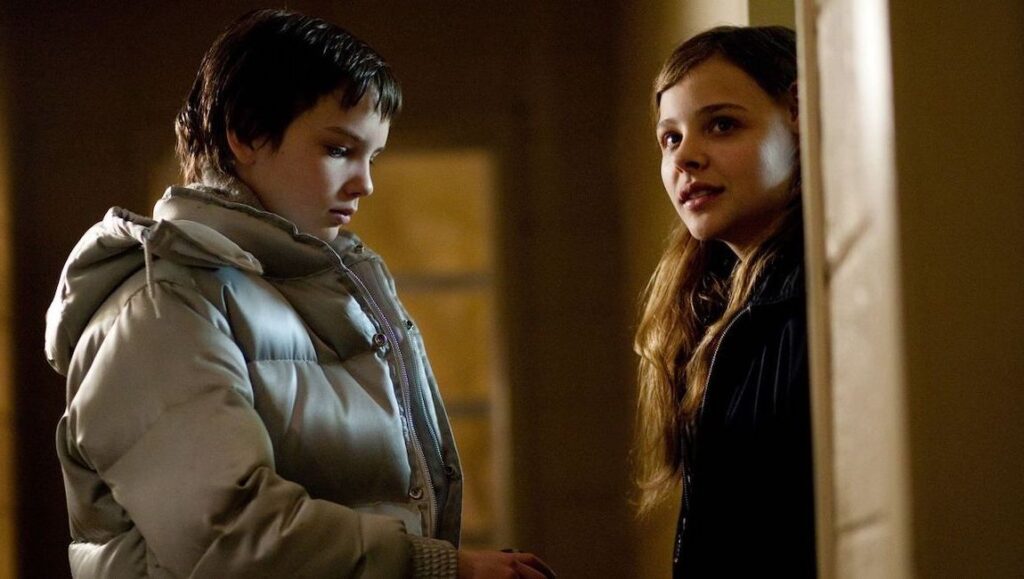Isolation is a universal theme, but it can also describe an intrinsically American experience of teenage angst. This contextual difference firmly separates Let the Right One In, Tomas Alfredson’s brooding Swedish vampire film, and Let Me In, Matt Reeves’s stirring but ultimately problematic remake. Even though both films are similar in style and scope, the European entry brilliantly focuses on the cutting loneliness of a young child coming to terms with the stark realities of a snowy adult world. Reeves’s grainy American retread, on the other hand, is a broader and more familiar example of teenage melodrama, wrapped in horror tropes. This difference is striking; because of it, Let Me In manages to improve on the original’s plodding first hour with head-on character flourishes while growing increasingly hollow and inert during the cramped dialogue sequences and bloody climaxes late in the film.
Unlike Let the Right One In, which opens with a hypnotic tilt descending from the dark wintry sky to a frozen jungle gym, Let Me In begins with a wide-angle view of a snowy forest landscape dissected by flickering police lights. It’s an aesthetic decision that favors action over subtlety, narrative over mood, and this discrepancy allows Reeves to upend the linear narrative and use flashback to build mystery for an American audience unaware of the original. But for those who’ve experienced Alfredson’s quietly revelatory beginning, this sequence reeks of Hollywood contrivance. Reeves redeems himself immediately with a telling introduction to the film’s 12-year-old protagonist Owen (Kodi Smit-McPhee), a pale and inquisitive lad who sits by himself on the jungle gym angrily recreating an inverse scenario with a school bully. After being called to dinner by his faceless mother, Owen steals a kitchen knife and ups the escalation of threats in his bedroom. Smit-McPhee’s mixture of panic and aggression feels palpable in these early moments, and even though the scenes are duplicates of the original, the performance brings a new sense of danger to Owen’s character.
By the time the mysterious Abby (Chloe Moretz) and her caretaker Father (Richard Jenkins) move into the apartment complex, Owen has already been effectively established as a ticking time bomb. From here, Let Me In focuses on the connection of outsiders finding solace in the company of fringe personalities; Abby and Owen bond over a similarly disaffected youthful experience. The fact that Abby is a vampire or that Father must murder to retrieve blood almost seems like an afterthought — just necessary plot points hit to please fans of the original film. But these early moments are elevated by Reeves’s fresh narrative additions, as when Owen and Abby mingle in a video game arcade watching Ms. Pac Man devour her prey, or when Father gets trapped in the back seat of a victim’s car, fully illuminated by gas station lights in a fine example of reverse horror lighting. The latter sequence becomes Reeves’s greatest cinematic coup, a brilliantly constrained set-piece shot entirely from the POV of the car as it crashes down a hill with crushing sound design. Even certain scenes that are directly copied from the original contain a sense of American estrangement from the outside world, as when Owen stabs a tree multiple times to let out his extreme frustration, or as he watches his mother yelling off-screen over the phone, Reeves’s camera lingering on his tormented face.
But Let Me In ultimately riffs on the original without fully committing to the story as a uniquely American experience. The brutal bullying and familial trauma, effectively rendered in the film’s first half, are never developed as the focus turns to Owen and Abby’s emotional longing. While Alfredson rightfully sidesteps romantic undertones by filling his version with ambiguous pauses and shifts in conversations between the children, Reeves makes it clear that Owen and Abby have feelings for each other. He even goes so far as to give them a basement to escape to whenever they need to talk intimately, which also turns out to be a convenient place to store a body when the blood starts to flow. Late in the film, the isolation felt in early scenes gets washed away by an obvious mix of recycled twists and uneven jumps in narrative logic. Instead of staying the course as a psychological children’s film, Let Me In tries to fulfill its box office potential by tacking familiar emotions and patterns onto its suffering pubescent characters (Romeo and Juliet becomes a key reference!).
Let Me In ends with the same gut-wrenching violence as the original, but the sequence lacks the necessary weight and mood of Alfredson’s more fractured imagery. While there’s plenty to admire in Reeves’ effort — most notably his desire to highlight sound design and character movement over flashy visuals — his film lacks an essential horror genre element. Tension. Even if you haven’t seen Let the Right One In (and many American audience members haven’t), Reeves’s film becomes enamored with the foregone conclusion of its melodramatic ending without situating its 1980s setting in a relevant social context beyond a few clips of Reagan and Now N’ Later candy. This is tween drama posing as Horror, and even though Let Me In squashes Twilight on all levels, it’s a lot closer to that ridiculously lousy franchise than most would like to admit.


Comments are closed.